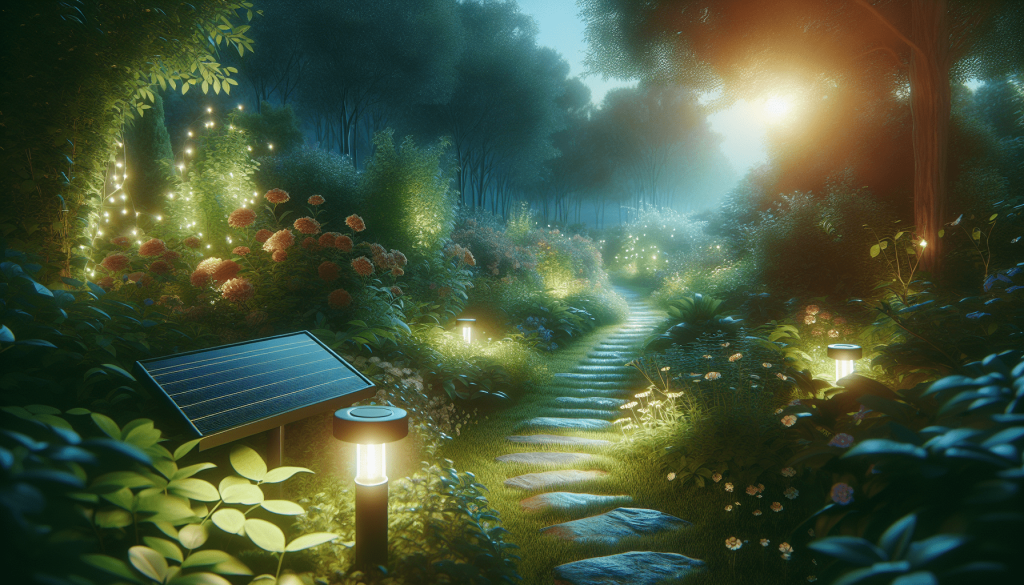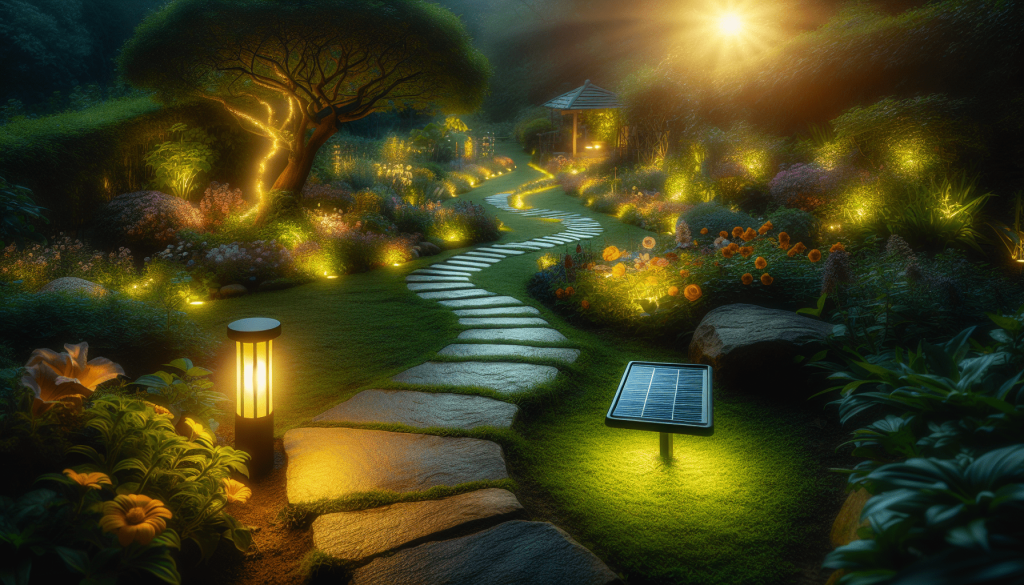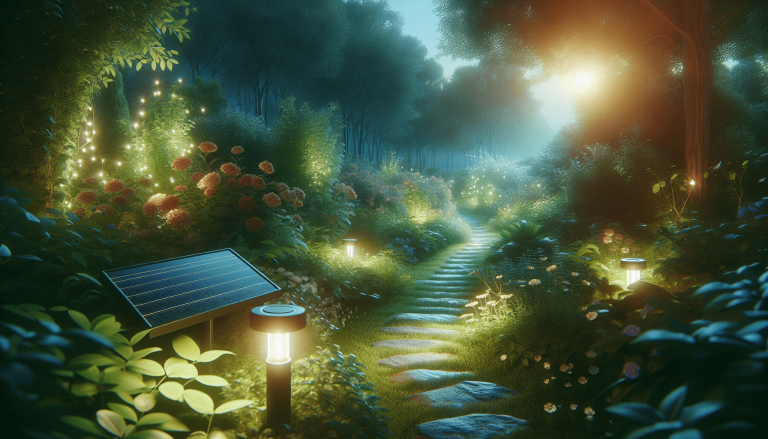Want to create an enchanting garden lighting setup without spending a fortune on energy bills? Look no further! In this article, you will discover the best practices for conserving energy in garden lighting. We will explore simple yet effective techniques that will not only save you money but also reduce your carbon footprint. From choosing energy-efficient bulbs and fixtures to optimizing the placement of lights, we’ve got you covered. Get ready to transform your garden into an environmentally friendly oasis that dazzles all night long.
Table of Contents
ToggleUse LED Lights
Explanation of LED lights
LED lights, or light-emitting diode lights, are a highly efficient and eco-friendly option for garden lighting. Unlike traditional incandescent bulbs, which generate light by heating a filament, LED lights work by passing an electrical current through a semiconductor material. This process produces light without generating excessive heat, resulting in significant energy savings and increased longevity compared to traditional lighting options.
Benefits of using LED lights
There are several benefits to using LED lights for garden lighting. Firstly, LED lights are highly energy-efficient, consuming up to 80% less energy than incandescent bulbs. This translates into lower electricity bills and reduced environmental impact. Additionally, LED lights have a longer lifespan, typically lasting up to 10 times longer than traditional bulbs. This not only saves money on replacement costs but also reduces waste. LED lights are also available in a variety of colors, allowing for creative and customizable garden lighting designs.
Types of LED lights suitable for garden lighting
There are various types of LED lights specifically designed for garden lighting. LED pathway lights are perfect for illuminating walkways and driveways, ensuring safety and enhancing the overall aesthetic appeal of the garden. LED spotlights can be used to highlight specific features or focal points, such as sculptures, plants, or architectural elements. Furthermore, LED string lights are a popular choice for creating a warm and inviting atmosphere in outdoor entertaining areas, such as patios or pergolas.
Choose Energy-Efficient Fixtures
Explanation of energy-efficient fixtures
Energy-efficient fixtures refer to lighting fixtures that are designed to maximize energy savings while providing adequate illumination. These fixtures often incorporate advanced technologies such as LED bulbs, efficient reflectors, and optimized optical designs to minimize energy waste.
Benefits of using energy-efficient fixtures
Using energy-efficient fixtures for garden lighting offers several advantages. Primarily, these fixtures consume less energy, resulting in lower electricity bills and reduced carbon footprint. By focusing the light where it is needed and minimizing light spillage, energy-efficient fixtures also help to reduce light pollution, preserving the natural beauty of the night sky. Moreover, these fixtures often have a longer lifespan, reducing the frequency of replacements and minimizing waste.
Types of energy-efficient fixtures for garden lighting
There is a wide range of energy-efficient fixtures available for garden lighting. Compact fluorescent lamps (CFLs) are an alternative to traditional incandescent bulbs, providing similar levels of brightness but using significantly less energy. Additionally, outdoor solar lighting fixtures utilize sunlight to charge built-in batteries during the day, providing illumination at night without the need for electrical wiring. Furthermore, there are energy-efficient LED fixtures specifically designed for outdoor use, such as floodlights and bollard lights, which offer efficient and focused illumination.
Install Motion Sensors
Explanation of motion sensors
Motion sensors are devices that detect movement within a given area and trigger the lighting system accordingly. These sensors use infrared or microwave technology to detect changes in heat or movement and activate the lights when someone enters the monitored space.
Benefits of using motion sensors in garden lighting
Installing motion sensors in garden lighting systems offers several benefits. One of the primary advantages is energy savings. With motion sensors, lights only turn on when movement is detected, eliminating the need for continuously illuminated areas when no one is present. This not only reduces energy consumption but also prolongs the lifespan of the lights, as they are used less frequently. Motion sensors also improve security by automatically lighting up dark areas when someone approaches, deterring potential intruders.
Types of motion sensors suitable for garden lighting
When it comes to motion sensors for garden lighting, there are various options available. Passive infrared (PIR) sensors are the most commonly used type and detect heat emitted by moving objects. These sensors are ideal for areas where human movement is expected, such as pathways or entry points. Microwave sensors, on the other hand, emit microwave signals and measure the reflections from nearby objects. These sensors are suitable for detecting movement behind obstacles or in areas where heat detection might be challenging, such as dense vegetation.
Utilize Solar-Powered Lights
Explanation of solar-powered lights
Solar-powered lights rely on renewable solar energy to charge their built-in batteries during the day, which power the lights at night. These lights feature small photovoltaic panels that convert sunlight into electricity, eliminating the need for electrical wiring and reducing reliance on fossil fuels.
Benefits of using solar-powered lights
The use of solar-powered lights in garden lighting offers numerous advantages. Firstly, solar-powered lights are highly energy-efficient, as they harness the sun’s energy, a renewable resource. This results in significant cost savings on electricity bills and reduces environmental impact. Solar-powered lights are also easy to install, as they do not require complex wiring or connections to the electrical grid. This makes them ideal for remote areas or gardens where installing electrical infrastructure may be challenging. Additionally, solar-powered lights provide independent operation, unaffected by power outages, ensuring continuous illumination.
Types of solar-powered lights for garden lighting
There is a wide variety of solar-powered lights suitable for garden lighting. Solar path lights are designed to illuminate pathways, driveways, and garden borders, providing both safety and aesthetics. Solar lanterns and string lights are popular options for creating a warm and cozy ambiance in outdoor entertaining spaces. For highlighting specific garden features or architectural elements, solar spotlights and floodlights offer focused and adjustable illumination. Solar-powered garden stake lights, shaped like flowers or animals, add a whimsical touch to the garden while providing illumination.
Consider Timers and Controllers
Explanation of timers and controllers
Timers and controllers are devices used to program and automate the operation of garden lighting systems. Timers allow users to schedule when the lights should turn on and off, while controllers provide advanced functionalities such as dimming, color changing, and remote control operation.
Benefits of using timers and controllers in garden lighting
Using timers and controllers in garden lighting brings several benefits. Firstly, these devices enable better control over energy consumption by allowing users to set specific schedules for when the lights should be on. This ensures that the lights are not left on unnecessarily during daylight hours or when they are not needed, resulting in energy savings. Additionally, some controllers offer the ability to adjust the brightness or color of the lights, allowing for versatile lighting designs and mood customization. Moreover, remote control functionality provides convenience, allowing users to operate the lights from a distance.
Types of timers and controllers suitable for garden lighting
Various types of timers and controllers are available for garden lighting systems. Mechanical timers are the simplest and most cost-effective option, allowing users to set specific on and off times. Digital timers provide additional flexibility, allowing for more precise scheduling and programming options. Advanced controllers, such as wireless smart controllers, offer features like dimming, color changing, and integration with home automation systems. These controllers are ideal for users seeking maximum control and customization of their garden lighting.
Use Low Voltage Lighting
Explanation of low voltage lighting
Low voltage lighting refers to a lighting system that operates at a voltage lower than the standard household voltage. Most low voltage lighting systems operate at 12 volts, significantly reducing electrical hazards and energy consumption compared to higher voltage systems.
Benefits of using low voltage lighting
Using low voltage lighting in garden lighting presents several advantages. Firstly, the lower voltage reduces the risk of electrical shock, making it safer for both installation and maintenance. Additionally, low voltage lighting systems consume less energy than higher voltage alternatives, resulting in cost savings and reduced environmental impact. These systems also offer more design flexibility, as low voltage lights can be installed in various locations without extensive wiring. Furthermore, the bulbs used in low voltage systems tend to have longer lifespans, reducing the frequency of replacements.
Types of low voltage lighting suitable for garden lighting
There is a wide range of low voltage lighting options available for garden lighting. Low voltage path lights are designed to illuminate pathways and driveways, ensuring safety and guidance. Low voltage deck lights can be installed on decks or patios to provide subtle accent lighting for entertaining areas. In-ground well lights are ideal for highlighting trees, shrubs, or architectural elements, adding depth and drama to the garden. Additionally, low voltage underwater lights can be used to enhance the visual appeal of water features, such as ponds or fountains.
Properly Position Lights
Importance of proper positioning
Properly positioning garden lights is crucial for achieving optimal lighting effects and maximizing their functionality. By strategically placing lights, you can highlight key features, enhance safety, and create a visually appealing garden atmosphere.
Tips for positioning garden lights
When positioning garden lights, consider the following tips:
- Highlight focal points: Use spotlights or well lights to draw attention to unique garden features like sculptures, fountains, or specimen plants.
- Illuminate pathways and stairs: Install path lights along walkways, garden borders, or staircases to ensure safe passage and create a welcoming ambiance.
- Create depth and dimension: Use a combination of uplights and downlights to add depth to the garden by illuminating trees, walls, or textured surfaces.
- Avoid glare: Position lights in a way that prevents direct glare, ensuring that the light is distributed evenly and does not interfere with visibility.
- Experiment and adjust: Test different light placements and angles to find the most flattering and functional positions. Adjust as needed to achieve the desired effect.
Considerations for different areas of the garden
Different areas of the garden may require specific lighting considerations. For example:
- Entertaining areas: Install string lights or lanterns in outdoor dining or seating areas to create a cozy and inviting atmosphere for gatherings.
- Plant beds and borders: Use low-level LED lights or well lights to highlight the texture and colors of plants while providing subtle illumination.
- Water features: Utilize underwater lights to illuminate ponds, waterfalls, or fountains, creating a captivating visual effect.
- Architectural elements: Place spotlights or wall-mounted lights near architectural features or structures, accentuating their beauty and creating architectural interest.
Avoid Overlighting
Explanation of overlighting
Overlighting refers to the excessive use or intensity of lighting in a given space. It occurs when more lights are used than necessary, leading to wasted energy, excessive light pollution, and an unnatural environment.
Negative impacts of overlighting
Overlighting can have several negative impacts on the garden and the environment as a whole. Firstly, excessive lighting can cause light pollution, which disrupts ecosystems, migratory patterns of wildlife, and the natural behaviors of nocturnal animals. Overlighting also wastes energy and contributes to unnecessary greenhouse gas emissions, resulting in increased carbon footprint. Moreover, overlighting creates an overly bright and unnatural atmosphere, detracting from the beauty of the garden and potentially causing discomfort for observers.
Tips for avoiding overlighting in the garden
To avoid overlighting in the garden, consider the following tips:
- Use light fixtures with adjustable brightness or intensity to ensure the appropriate amount of light for each area.
- Choose lighting fixtures with properly directed beams to minimize light spillage and prevent unnecessary bright spots.
- Utilize timers, motion sensors, or controllers to activate lights only when needed, avoiding continuous illumination.
- Consider the natural light available in the garden and leverage it by using fewer artificial lights during daylight hours.
- Regularly assess the lighting design and adjust as necessary to maintain a balanced and harmonious garden ambiance.
Regular Maintenance
Importance of regular maintenance
Regular maintenance is essential for ensuring the longevity and optimal performance of garden lighting systems. Proper maintenance helps prevent malfunctions, extends the lifespan of light fixtures, and ensures continued energy efficiency.
Tasks involved in maintaining garden lighting
Regular maintenance of garden lighting systems may include the following tasks:
- Cleaning: Regularly remove accumulated dirt, debris, or cobwebs from light fixtures to prevent obstruction of light output and maintain clarity.
- Checking connections: Inspect wiring connections, junction boxes, and transformers to ensure they are secure and free from damage.
- Replacing bulbs: Regularly check and replace any burned-out bulbs promptly to maintain consistent illumination.
- Inspecting fixtures: Check for signs of corrosion, damage, or wear on light fixtures and replace or repair as needed.
- Testing performance: Periodically check the functioning of motion sensors, timers, or controllers to ensure they are operating correctly.
- Adjusting positions: Over time, lights may shift or need repositioning due to landscape changes. Regularly assess the positioning and adjust as necessary.
Recommended frequency for maintenance
The frequency of maintenance tasks may vary depending on factors such as weather conditions, the type of fixtures used, and the size of the garden. However, a general guideline for maintenance is to perform regular checks and cleaning every 3-6 months. Routine bulb replacements should be done promptly as needed to ensure consistent illumination.
Educate Yourself About Energy-saving Techniques
Importance of energy-saving techniques
Educating oneself about energy-saving techniques for garden lighting is crucial for promoting sustainability, reducing electricity consumption, and minimizing environmental impact. By utilizing these techniques, individuals can make informed choices that contribute to a greener and more energy-efficient future.
Resources for learning about energy-saving techniques
There are several resources available for learning about energy-saving techniques for garden lighting. Online research can provide access to articles, blogs, and forums dedicated to energy-efficient outdoor lighting practices. Home improvement stores often offer workshops or guides on energy-saving lighting options and techniques. Additionally, consulting with landscape architects, lighting professionals, or energy specialists can provide expert advice tailored to individual needs and garden requirements.
Examples of energy-saving techniques for garden lighting
Some energy-saving techniques for garden lighting include:
- Use timers or controllers to ensure lights are only on when necessary, reducing wasted energy.
- Combine solar-powered lights with motion sensors for efficient and independent operation.
- Opt for LED lights, which consume less energy and have a longer lifespan compared to incandescent bulbs.
- Consider zoning or grouping lights to illuminate specific areas or features rather than lighting the entire garden uniformly.
- Regularly maintain and clean light fixtures to maximize efficiency and prevent unnecessary energy consumption.
- Install energy-efficient fixtures that utilize advanced technologies, such as LED bulbs or reflector designs, to minimize energy waste.
By implementing these energy-saving techniques, individuals can achieve beautiful and functional garden lighting while minimizing their impact on the environment and reducing their energy consumption.








